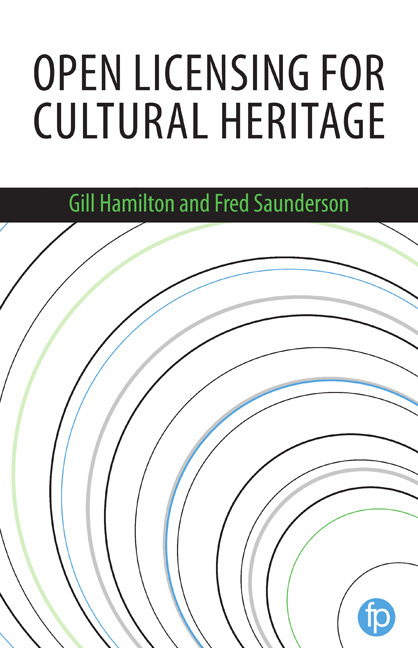Book contents
- Frontmatter
- Contents
- List of figures and tables
- Acknowledgements
- About the authors
- 1 Introduction
- 2 The open movement: its history and development
- 3 Copyright and licensing: a background
- 4 Open licensing: the logical option for cultural heritage
- Introduction to case studies
- 5 Small steps, big impact – how SMK became SMK Open
- 6 The British Library experience of open metadata licensing
- 7 Open policy and collaboration with Wikimedia at the National Library of Wales
- 8 Newcastle Libraries – the public library as a place to share culture
- 9 Developing open licensing at the National Library of Scotland
- 10 The Wellcome Library
- 11 Developing an open educational resources policy and open approaches to mitigate risk at University of Edinburgh
- 12 How to implement open licensing
- 13 Using and reusing openly licensed resources
- 14 Conclusion
- Index
9 - Developing open licensing at the National Library of Scotland
Published online by Cambridge University Press: 08 June 2018
- Frontmatter
- Contents
- List of figures and tables
- Acknowledgements
- About the authors
- 1 Introduction
- 2 The open movement: its history and development
- 3 Copyright and licensing: a background
- 4 Open licensing: the logical option for cultural heritage
- Introduction to case studies
- 5 Small steps, big impact – how SMK became SMK Open
- 6 The British Library experience of open metadata licensing
- 7 Open policy and collaboration with Wikimedia at the National Library of Wales
- 8 Newcastle Libraries – the public library as a place to share culture
- 9 Developing open licensing at the National Library of Scotland
- 10 The Wellcome Library
- 11 Developing an open educational resources policy and open approaches to mitigate risk at University of Edinburgh
- 12 How to implement open licensing
- 13 Using and reusing openly licensed resources
- 14 Conclusion
- Index
Summary
Introduction
From unplanned, somewhat opportunistic beginnings, the National Library of Scotland has been openly licensing resources since 2008. The Library's approach to open licensing has taken a more strategic and considered direction since 2014 by developing structured policies and procedures. In this case study we examine this, from the Library's early openness steps driven primarily by external factors to the Library's more recent approaches to being open, which derive from greater internal drivers while continuing to be informed and inspired by external developments. We argue that this development process demonstrates how, even when setting out initially with no openness plan, cultural heritage organisations can develop open approaches and use open licences successfully.
Exploring external drivers
The National Library of Scotland's earliest use of open licences begins with the web. The Library's first website was developed in the mid-1990s, driven by the potential to reach a larger, more diverse audience. Mainly text-based, this first website iteration had only a few images, including the Library's logo and a few of the Library's treasured collection items.
This lack of imagery was not unusual for the time. Expensive, low-resolution (compared with today) digital cameras were in their infancy and just being introduced to the non-professional market. Tools to manipulate digital images were basic. Domestic connection speeds were slow, between 28 and 56 kilobytes per second, more than 1000 times slower than the fibre speeds (up to 76 megabytes per second) we are familiar with today, so users were likely to be dissuaded by image and data-rich websites.
All text and images on this first website iteration were marked ‘© Copyright Trustees of the National Library of Scotland’. Open licensing, largely limited at this time to the software industry, was not considered. Easily accessible, publicfocused, generic open licences, such as Creative Commons licences, were not yet available. This type of ‘all rights reserved’ copyright notice was used less by design and more by default: there were no real alternatives, nor was the intellectual openness of this nascent communication channel high on the organisational agenda.
Digitisation efforts at the Library commenced around this time, progressing in an ad hoc manner with basic scanners and digital camera equipment. The initial aim of this work was to create images for the website and for exhibitions.
- Type
- Chapter
- Information
- Open Licensing for Cultural Heritage , pp. 137 - 148Publisher: FacetPrint publication year: 2017



